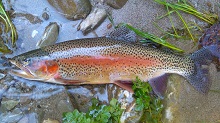B.C. Fisheries Threatened?
Canadian Angling.com (July 31, 2012) — Recent research by scientists have revealed that a deadly virus is now threatening the B.C. sport fishing industry. The research was completed by Simon Fraser University professor Rick Routledge and Stan Proboszcz, a fisheries biologist at the Watershed Watch Salmon Society. They discovered that the piscine reovirus (PRV) have infected the cutthroat trout caught in Cultus Lake. Testing was completed by virology professor Fred Kibenge, from the Atlantic Veterinary College in Prince Edward Island. He found the virus present in 13/15 sampled fish. Further research into the virus found that it was 99% genetically identical to Norwegian strains.
This virus attacks the heart and causes skeletal muscle inflammation (HSMI). The virus is widespread in Norwegian salmon farms and it has caused a 20% mortality rate.
Rick Routledge thinks that this may be the first evidence of PVR in B.C. freshwater sport fish and that this virus may be widespread. This may be one of the causes for the recent drop in the natural salmon populations in B.C. There are many scientists and interest groups who are extremely concerned about the transmission of diseases from fish farms to the wild Pacific salmon stocks.
He said that “If PRV has been found in a Cultus Lake sport fish it could be contributing to the failure of the lake’s sockeye population to return in abundance/” This species has been listed as endangered by the federal government. He also added that “the discovery of PRV in Cultus Lake’s cutthroat trout also begs the question is it in other related species in the lake, such as rainbow trout, kokanee and Dolly Varden? This latest discovery could also mean that salmon and trout in any lake exposed to spawning salmon returning from the North Pacific must be considered at risk of infection.”
Recent research this year by Alexandra Morton, an independent biologist, who works with Routledge, also discovered PRV in Atlantic salmon sold in B.C. stores.
Sadly, the story doesn’t end here. PRV is only one of the two viruses associated with salmon farming that they have found in trout and wild Pacific salmon. Research completed last fall by Morton and Routledge found sockeye salmon smolts infected with infectious salmon anemia virus (ISAv). This disease causes severe anemia in the infected fish. There is one major difference between mammals and fish red blood cells. The fish red blood cells have DNA, and can become infected with viruses. The virus attacks the fish’s gills and the fish swim close to the surface, gulping for air.
The federal government is presently investigating the declining population of sockeye salmon in the Fraser River at the Cohen Commission Inquiry. The results of the scientists investigations have been given to the Inquiry and their findings will be released this fall.
Craig Orr, the executive director of Watershed watch stated “we discovered during the Cohen inquiry that pathogens are a major concern for B.C.’s salmon. Our findings suggest we need to broaden our thinking and concerns for freshwater fish as well.”
Routledge also added that “there are many examples of devastating impacts of introduced pathogens in human, mammal and marine populations. When small pox was introduced to North America it decimated the aboriginal population, which had not had any previous opportunity to build up a natural immunity to the disease. The potential for this to happen to B.C.’s highly valued Pacific salmon and trout populations must be taken seriously.”
Wayne Sheridan for Canadian Angling.com



